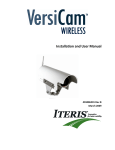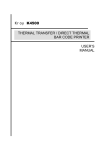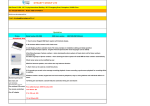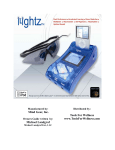Download to view a PDF of the Ridekick User Manual
Transcript
Discover what’s beyond. Ridekick™ power trailer assembly instructions Congratulations on purchasing the Ridekick™ power trailer. Now, you can rev up every ride and discover what’s beyond – no matter where you’re going, what you’re taking with you, or what you’ll be bringing back. Find your beyond… DMK Colorado, LLC 320 E. Vine Dr., Suite 219 Fort Collins, CO 80524 877-974-4440 fax 970-315-3535 www.ridekick.com Ridekick will get you there. Parts list • • • • • wire, hitch plate, and safety strap 1 short Allen head screw (A) 1 self-locking nut (B) 1 long Allen head screw (C) 2 spacers (D) hitch arm 1 acorn nut (E) 1 throttle with cord and straps attached 1 battery with bag 10 hook and loop straps 1 battery charger 1 Ridekick power trailer base unit 1 Ridekick power trailer lid Tools required for assembly 4 mm Allen wrench (included) D B • 1 hitch arm with hitch pin and keeper • • • • • • C A E (A) short Allen head screw (B) self-locking nut charger (B) or hitch arm 3 hitch arm (A) throttle with cord and straps attached security loop (C) hook and loop straps throttle cable (D) (E) hook and loop straps 2 1 battery with bag and charger 10 mm box wrench (not included) or pliers If your bike does not have a quick-release axle on the rear wheel, a wrench is required to remove rear axle nut. If any parts are missing or damaged, please contact Ridekick Customer Service at 877.974.4440 or [email protected]. Battery Care Step 1: Secure Hitch Arm Step 2: Attach Throttle Cable To enjoy a long first ride, make sure your battery is fully charged. To charge your battery, plug the red and black connectors on the charger to the red and black connectors on the battery. Then plug the charger into a standard (110 to 240 volt) outlet. After Step 3, you can charge the battery by plugging the red and black connectors on the charger into the top of the controller. For more information, read the front and back of the Battery Care Card located in the window slot on top of the battery bag. Let’s get this going. Stand your Ridekick power trailer upright and insert the hitch arm into the tube fitting until the top and bottom holes align. Place the short Allen head screw (A) into the top hole and attach the self-locking nut (B). DO NOT TIGHTEN. Insert the long Allen head screw (C) into the bottom hole. Set your Ridekick down, unlatch the combination lock, and open the lid. Locate where long Allen head screw (C) is protruding inside the base compartment and thread the spacers (D) onto the screw. Then attach the acorn nut (E) and tighten. Put the lid back on (if necessary), close the lid, and stand the Ridekick power trailer up. Snugly tighten the nut (B) on the short Allen head screw (A). Run the throttle cable along the top of the hitch arm and secure the cable to the hitch arm using 3 hook and loop straps. Thread the plug of the throttle cable through the security loop on the hitch arm. hook and loop straps hitch plate D-ring bike frame hitch pin skewer keeper wire quick-release lever hitch arm safety strap bike frame throttle Step 3: Connect Battery Step 4: Attach Hitch Plate Set your Ridekick power trailer down. Open the lid and set the battery pack inside the base compartment in front of the control box with the logo facing toward the back. Make sure the control panel is in the OFF position by pushing the OFF button. Connect the battery to the side of the control box using the black and red connectors. Firmly strap the battery down using the hook and loop in the base compartment. Not strapping the battery down may result in damage to your Ridekick power trailer. Unsnap the keeper wire from the hitch pin on the top of the hitch arm and remove the pin and hitch plate from the hitch arm. Open and unscrew the quick-release lever* on the rear axle of your bike. Hold the lever and pull the axle skewer all the way out. Thread the skewer through the hole in the hitch plate. Reinsert axle skewer through the rear axle. Angle hitch plate slightly downward and securely tighten the quick-release lever. *Note: if your axle has no quick-release lever, remove rear axle nut, thread hitch plate onto bolt, and retighten nut. Step 5: Connect Ridekick Power Trailer Slide the hitch arm onto the hitch plate aligning the hole in the hitch arm to the hole in the hitch plate. Insert the hitch pin through both holes and snap the keeper wire closed. Loop the safety strap around the bike frame* and clip it to the D-ring. *Note: If there is excess safety strap that may interfere with your biking operations, wrap it around the hitch arm or bike frame so it does not get caught in your spokes. Step 6: Attach Throttle Attach the throttle to one of the handlebars, keeping your comfort in mind. Avoid interference with braking and shifting operations, and use the hook and loop straps attached to the throttle to secure the throttle to the handlebar. After installation, test the throttle to ensure it stays in place and that the brakes and gear shifters function properly. DO THIS SAFETY CHECK hook and loop straps throttle cord Testing Your Brakes with a Ridekick Trailer leave slack throttle cable Like we tell our kids: “Have fun, make good decisions, and be safe!” We realize that the Ridekick power trailer is many people’s first experience with an electric-assist for bikes. Please read and become familiar with this safety primer. If you are prepared and a little practiced, unexpected events can be handled more safely. Step 7: Connect Throttle Cord and Cable Returning to the rear axle, connect the throttle cord to the throttle cable on the hitch arm. Step 8: Secure Throttle Cord to Bike Starting at the rear axle, secure the throttle cord to the bike frame with the hook and loop straps, making sure they do not interfere with any other cables that run along the bike frame. Continue this process up to the handlebars and, using the hook and loop straps, bind the excess cord to the brake and gear cables at the handlebars. Keep any excess cord away from all moving parts and rotate the handlebars to ensure that you have enough slack to fully turn your handlebars. battery check button Be sure to consult the user manual for information regarding warnings, care, maintence and use of the Ridekick power trailer. 4 charge port scroll button power button Step 9: Turn On and Go This is what you’ve been waiting for! Turn your Ridekick power trailer on by pushing the ON button. To make sure everything is working properly and there is sufficient battery level, check the readout screen on the front of the control box. L0 - L9 indicates battery level (L0 = low battery and L9 = full battery). Secure the lid and get ready for the ride! The throttle is ready to help you find your beyond. Now go... Want a personalized expression that matches your experience? Accessories are available for your Ridekick power trailer. Visit ridekick.com for pricing and ordering information. If you have any questions about the assembly or safe operation of the Ridekick power trailer, contact Ridekick Customer Service at 877.974.4440, ext. 2 or [email protected]. Get on with your beyond. Discover how. ridekick.com © 2011 Ridekick International. All rights reserved. Ridekick is a trademark of DMK Colorado LLC. The braking needed for a bicycle with a Ridekick trailer attached is normal braking power for any bike with its brakes in good condition. 1) Your brakes should stop a Ridekick trailer when the throttle is at full power. On your next ride, test your brakes. The goal is to have your brakes stop your bike while the motor is providing full power. a) Get on your bike, apply your bicycle brakes. Activate the throttle for 3 to 5 seconds and verify that your bicycle doesn’t move. ** If your bicycle can’t be stopped, service your brakes immediately. ** Also note if your hitch plate twists, then tighten the skewer or axle nut. b) Get on your bike, activate the throttle so you gradually accelerate up to about 15 mph. Then while keeping the throttle fully pressed, use your brakes to safely come to a full stop while steering straight ahead. The motor will be pushing you while you stop. ** If your brakes don’t stop you soon enough, then the brakes need maintenance immediately. (You need good brakes even without a power trailer.) As a general practice, do not apply motor power while brakes are applied because it drains the battery and heats up the controller. However, this is recommended for the purpose of testing your brakes, but shouldn’t be continued for more than 20 seconds. As a safety backup, the controller will stop motor power after 20 seconds of high power and no movement. Repeating this test within 5 minutes can damage your controller. 2) Whenever you are stopped with your power trailer, stay on your bike and keep your brakes engaged. ** Your weight along with the bicycle brakes keep the bike and trailer stopped. ** Much like driving any power vehicle (a car or motorcycle), always use your brakes at intersections, overlooks, or on hills. “Our mission is to enable more people to ride, enjoy the outdoors, live more healthy and sustainable lives, and have fun. While enjoying the bike paths and streets with the assist of a Ridekick trailer, be courteous to others, pass safely, follow the rules of the road, and build a good name for the cycling community.” - Mark Wanger, President and Founder of Ridekick International SAFETY FIRST! “Kicking” Tips When you take your Ridekick power trailer on its first “spin”, double check that all nuts are tight, that Ridekick power trailer parts have been put together correctly and are secure. Check your bicycle brakes for stopping efficiency with the Ridekick power trailer. Follow instructions for the brake check (enclosed.) Only attach the Ridekick power trailer to a bicycle that is in a good state of repair and has the hitch plate installed correctly and securely. Ensure that the bicycle frame, wheels, gears, chain, handlebars, tires, brakes, and cables are in proper working order. Here are a few tips we have discovered that may help give you a better ride and more fun “kicking”: ●● If you reduce the tire pressure on the Ridekick you will have a smoother ride. It’s best to lower it to 15-20 psi (the tire can go up to 35 psi). ●● Tighten down the hitch plate on your bike. If it isn’t tight enough the hitch plate will rotate, bringing the nose of the Ridekick close to or touching your rear tire, which will leave a black mark on the nose of your trailer. ●● When you close the lid to go for a ride, spin one or more numbers on your latch/lock. This will keep the lid closed if you happen to hit a big bump. ●● Remember, you have a trailer behind you. When turning don’t cut the corner too tight or your trailer tire may hit the curb, and may cause the trailer to flip. ●● Do not apply power when turning, especially when traveling on a bumpy surface. Flipping can result. Check hitch connection and safety strap before every ride. Always wear a helmet. Warnings Do not use the Ridekick power trailer if any parts are damaged! Surface and Terrain The Ridekick power trailer is best suited for use on paved roads and trails. It is not designed, nor recommended, for use on dirt or gravel roads and trails, or in >2” deep water. Wheels may slip on dirt or gravel roads and trails, and won’t propel the bike evenly. Use on dirt, gravel, sand, or deep water will invalidate the warranty. Speed Keep your speed at levels appropriate to road conditions. Make turns and travel on uneven or irregular terrain with lower speeds. Moving at high speeds in these conditions can result in jostling, “whipping” and flipping of the Ridekick power trailer, causing damage to power trailer or load, or causing erratic movement of the power trailer. Wet Conditions Exercise caution in wet weather conditions or on slippery terrain as these affect braking distance and the grip of the trailer tires. Avoid going through water puddles or enabling controller to get doused with water. Visibility Avoid cycling in poor visibility conditions such as fog, night, heavy rain and snow. Use appropriate lighting if you must ride in these conditions. The Ridekick power trailer has a tail light, but regular bicycle lighting is recommended. Accelerating and Intersections Though you have an extra boost with power, cross streets or pass other vehicles with caution as though you are providing all the power with your body. Learn to judge your start-up power so that you don’t overestimate your speed and ability to get safely across a street or around other vehicles. Traffic Be careful when in traffic. Your vehicle is a bicycle, not a motor vehicle (US Public Law 107-319). Drivers will expect it to move at speeds and in ways that bicycles do. Laws Always abide by local, county and state laws for bicyclists or laws regarding 500-watt motors on vehicles that travel at less than 20 miles per hour. Braking Take care to brake with awareness of the weight of the load in the carrier. The bicycle does the braking for the bike, the rider, and the Ridekick power trailer, so exercise caution. Anytime you are stopped and the Ridekick power trailer is turned on, keep your hands on the brakes to avoid accidental throttle contact. Inspect Before every ride, make a quick inspection of your Ridekick power trailer mechanical and electronic features. Wheels and Tires Check the nuts that hold the wheels on and ensure that the tires are inflated to the correct pressure. Extend Your Range If you are looking to extend your battery’s range, there are a few ways to get more miles out of your battery before having to recharge it: ●● Engage the throttle for 15 miles per hour of assist instead of using the full 19 mile per hour boost. ●● Pedal without the assist from a stop until you’re going 3 - 4 miles per hour before you engage the motor. Power Settings You have the choice between two power settings, P1 or P2. P1 will be less powerful and give you better range; P2 will give you more power starting from a stop and climbing hills, but will use up the battery quicker. The controller comes preset with P2 as the setting. To change between P1 and P2: ●● Turn the controller on. ●● Press and hold the BATTERY button. ●● Press the NEXT button to toggle back and forth between P1 and P2. ●● Release all buttons when you are on the desired setting. ●● Press the BATTERY button to get out of the power setting mode and back to the battery level mode. Charger Storage Moving Parts Always attach cables, cords, straps and clothing securely away from moving parts on the bike, rider, and Ridekick power trailer. Keep the throttle cable “on a very short leash” so that it cannot catch in the spokes or gearing and get pulled apart or interfere with safe performance of the bike. The same is true of the safety strap. It should not restrict hitch articulation but also should not dangle dangerously. Use the mesh pouch sewn onto the battery bag to store your charger so it’s always handy. Safety Strap Only operate the Ridekick power trailer with the safety strap secured to the frame of the bike and clipped securely to the D-ring. Using walkie-talkies or 2-way radios on the handle bars, near the throttle wire, or near the trailer, can possibly seize the controller. Some instances have been reported where the controller can get stuck with motor power on. Do NOT use 2-way radios while riding with a Ridekick power trailer. Cargo Load The maximum load is 75 pounds. Do not exceed this weight or damage may occur. Do not carry people or animals in the container. Do not carry flammable objects or materials. Packing the Cargo Load When you put items in the cargo area, be sure to load them in a manner that balances the weight and protects items if they are fragile. The Ridekick power trailer will bounce on any road irregularities, jostling the load accordingly. Battery Strap Make sure the battery is secured against the control box during operation. Lid Operating the Ridekick power trailer without the lid can lead to damage of goods and the controller. Only operate the Ridekick power trailer with an approved lid. Do not carry any weight ON the lid. Heat When parking the Ridekick power trailer in the sun, remove personal items to avoid damage from heat. Controller Do not put any object into the USB port, battery connector, motor connector, throttle connector or controller that is not designed to be put into it. Cables and Cords Protect cables and cords from breaks in the plastic sheath. Replace if wire becomes exposed. Security The hitch arm has a security loop on it for use with a bicycle lock. You may use this loop or the wheels to secure your Ridekick power trailer to a fixed object to prevent theft. Always lock the latch to prevent theft. Two-way Radio Warning If 2-way radio interference causes the motor to run, use your bicycle brakes to stop safely and hold the brake for 20 seconds. Remain on your bike and do not get off until the controller turns off. Cell phones and wireless speedometers are OK to use. Hill Climbing When climbing hills with the Ridekick trailer power, it is necessary to pedal along to maintain a speed of no less than 7 miles per hour. If your speed drops below 7 mph, the controller will become too warm, and automatically turn off the motor so overheating doesn’t occur. User Manual Always exercise caution when handling your battery. Do no drop the battery. To charge either battery: 1. Turn Ridekick trailer power OFF. 7. When the charger light is green again, the battery is 2. Insert the charger plug into your household outlet. fully charged. 3. Look for the light on the charger to be green. 8. Unplug the charger from the wall and from the trailer 4. Insert the power connector into the port on the top of console. For best care of the charger, do not leave it the Ridekick control panel or directly into the battery plugged into the outlet for more than 24 hours. cable. 9. Store charger in battery mesh pouch. 5. Look for the light on the charger to go from green to 10. It may take up to 6 hours for an SLA battery, and 3.5 red. hours for a LiFePO4 battery. 6. You now know that you have a good connection to the battery and that it’s charging. Charger Doing Its Job: The charger is working well if it is warm to the touch. To avoid fires and heat damage, and to allow your charger to work well, use the charger in an open area with no other objects touching it. Once the battery is full charged, it is advised that you disconnect the battery from the charger, unplug the charger from the wall and store it in the battery bag. Other Chargers: Use only the charger provided with your Ridekick power trailer. The use of other chargers will invalidate your warranty, and could damage your battery or cause a fire. Other Charging Details: • The battery may be charged while your Ridekick power trailer is connected to the bicycle. • You may remove the battery from the Ridekick trailer to take the battery inside to charge. Unplug the battery’s red/black connectors from the side of the control box, and release the hook and loop strap from around the battery. Use the carrying straps to carry the battery. • If the battery won’t accept a charge, contact support at ([email protected]) for more information. • Do not charge the battery if the connectors are wet, and never allow children to play with the battery or charger. Sealed Lead-Acid (SLA) Battery Care To assure the longest life of your battery, be diligent about charging. How Your Battery Works: When a sealed lead-acid battery is working to give you power, sulfate collects on an internal plate. When you recharge the battery, the plate is cleared of the sulfate collected there. If you let your battery sit for 3 or more days without recharging fully, the sulfate collected on the plate will crystallize. When it’s crystallized, it sticks to the battery and can’t be removed. This changes the amount of charge the battery will hold from that point forward. With the right use and maintenance care of your battery, it will take you far beyond its average life span of about 400 charges! More is Better: Always charge your battery at the end of the day you used it. There’s no danger of overcharging it. Keep a Charge on Your Battery: Do not leave your battery with any amount of discharge for more than 3 days. The battery will continue to self-discharge over time if not in use, resulting in damage, and potentially shortening the distance you can go on a charge. Even if not using the Ridekick power trailer regularly, the battery should be charged at least one time per month for one hour. So, keep it charged as full as possible. Your diligence will ensure a long life for your battery. Battery in Heat and Cold: When temperatures drop below 40oF (4.4oC) or rise above 95oF (35oC), bring your battery indoors for charging and storage. Temperatures lower than 40oF (4.4oC) significantly lower battery capacity, and you decrease the distance you will get from that charge. For example, if you use the power trailer to give you a boost for 5 miles to your workplace, then leave the battery outside in 35oF (1.5oC) over a 3 - 8 hour period, you may only be able to go another 3 miles with a boost. Lithium (LiFePO4) Battery Care important to charge it when it’s at L1 or lower. To ensure the longest life of your battery, charge it after use. However, it’s most More is Better: There is no danger of overcharging your battery. This battery should provide power for at least 25,000 miles, or 1000 full charge cycles. It’s possible for you to extend that to 1500 – 2000 full charge cycles with diligent care such as charging at the end of each day of use, recharge every 2 months when stored, and store it fully charged. Keep a Charge on Your Battery: Do not leave your battery with lower than a L0 discharge for more than 3 days. The battery will continue to self-discharge over time if not in use (about 3% per month), resulting in damage, and potentially shortening the distance you can go on a charge. The Ridekick control system won’t let you discharge the battery lower than L- while in use. At times when you are not using the Ridekick power trailer regularly, the battery should be stored in a cool, dry place, away from any heat sources, and should be charged at least twice per month for one hour. Your diligence will ensure a long life for your battery. Battery in Heat and Cold: When temperatures drop below 0oF (4.4oC) or rise above 110oF (35oC), bring your battery indoors for charging and storage. Temperatures lower than 0oF (4.4oC) or higher than 110oF give you about 70% or less distance on the charge. For example, if you use the power trailer to give you a boost for 10 miles to your workplace, then leave the battery outside in 0oF (1.5oC) over a 3 - 8 hour period, you may only be able to go another 10 miles with a boost. Control Panel 4 1 2 3 4 5 6 7 8 1. 2. 3. 4. 5. 6. 7. 8. Fuse Slot Charger Port Battery Level and Low Battery Warning Forward to Next Error (if more than one) Problem Light – Check Diagnostic Panel USB Port (see note below) On Button Off Button USB Port The USB port on the control panel can be used for charging mobile devices and to receive firmware updates from Ridekick International. Through the USB, the controller is designed to deliver up to 100 mA and the port can be used when the trailer is turned on or in use. Maintenance Lubricate the drive chain with a bicycle chain lubricant every 100 miles or once a month, whichever is more frequent. Always disconnect the battery before working with the drive train. Setting Your Latch Combination When you receive the Ridekick power trailer, the latch combination will be set to “0-0-0”. You can select and set a different number that is easy for you to remember. 1. Open the latch and remove the lid so you have easy access to the underside of the combination portion. To remove the lid, open it to about 45O and while holding both sides of the lid, pull the left side away from the frame and remove the entire lid. Assure that the combination is set to 0-0-0. 2. Use a pointed object (i.e. a pen) to push the “coder” against the metal plate, pressing first to the right, then (up) toward the Ridekick power trailer until the coder stays in place. Put the pointed object aside. 3. Looking at the dials as in photo A, turn the dials to the numbers of your choice, with the numbers centered on the dial. It cannot be rolled past 0-0-0, so reverse direction to desired number. 4. Using the pointed object, return the coder to its starting position, set the pointed object aside, and try your new combination! A Coder Troubleshooting Diagnostic System The Ridekick power trailer has an LED diagnostic system to enable you to solve common problems. The first thing to try is to turn the unit off, and then on again. If that doesn’t solve the problem, with the controller turned on and the throttle plugged in, read and respond to the message on the diagnostic panel. If you don’t get a reading, check to make sure the black and red battery connector is plugged into the side of the control box. Message What to Do Battery level low to high. L9 = take it for a spin! Be aware of your charge level to anticipate how far you can go with a boost. The battery will stop providing power when it gets to L0. Charge battery - today! The battery is low, not completely discharged. Charge battery immediately! The battery is in danger of permanent damage. Go to ridekick.com/spport. Ridekick International support team will help diagnose the battery problem. Connect throttle jacks. See Step 7 in the Kickstart Guide. Disengage throttle lever. Make sure the spring is separating the throttle lever from the throttle body. Replace fuse. Additional fuses (ACT/ATO 40 amp) can be found at any auto parts stores. Check motor connector. On the side of the control box, look for the black and green motor connector. Make sure it is completely connected. Go to ridekick.com/support. Ridekick International’s support team will help diagnose the problem. Unplug USB. The device that is plugged into the USB port is demanding more power than the controller is designed to deliver. Push the OFF button, then the ON button to reset the USB port. Turn unit off and allow controller to cool for 10 minutes. Drive Chain Breaks If your drive chain breaks, please call Ridekick’s customer support line at 877-974-4440 ex 2 or email at [email protected]. Ridekick Trailer Facts Warranty NOTICE: Register your product at: www.ridekick.com/products/register. Weight 43 pounds (19.55 kg) Dimensions 24” wide x 39” long* x 17” tall (61 x 99 x 43 cm) *unit length w/o hitch arm is 22” (56 cm) Motor 500-watt brush motor Battery Pack Sealed Lead-Acid – 24v, 12 A-h, 18.8 pounds (8.5 kg) OR LiFePO4 – 24v, 20 A-h, 13 pounds (5.9 kg) Controller Efficient power control, LED diagnostic system, battery-drain protection Speed Control Regulated by hand-operated throttle. 19 mph (30.5 kph) maximum speed Charger UL Certified Smart Charger SLA full charge time = 6 hours. Temp best 41°F – 95°F (5°C – 35°C), LiFe full charge time = 3.5 hours. Temp best at 0° – 110°F (-17°C – 43°C) Distance SLA = 10 – 12 miles, LiFePO4 = 25 – 30 miles : Dependent on 1) weight of rider and load, 2) terrain, 3) tire pressure on bike and Ridekick power trailer, 4) temperature, 5) amount of pedaling assist Fuse 40 amps (ACT/ATO 40 amp - found at auto parts stores) RIDEKICK INTERNATIONAL warrants that the product will meet the specifications stated in the instructions and RIDEKICK INTERNATIONAL agrees to replace the product free of charge if the product does not conform to the specifications. Notice for replacement must be given within 60 days of the discovery of the defect. In consideration of the above promises by RIDEKICK INTERNATIONAL, the buyer agrees to and accepts the following conditions: • That this warranty is in lieu of all other warranties, expressed or implied; • That ALL WARRANTIES OF MERCHANTABILITY OR OF FITNESS FOR A PARTICULAR PURPOSE ARE HEREBY EXCLUDED AND/OR WAIVED; • That the buyer’s sole remedy shall be to obtain replacement of the product free of charge from RIDEKICK INTERNATIONAL; and That this remedy is in lieu of all other remedies or claims for damages, consequential or otherwise, which the buyer may have against RIDEKICK INTERNATIONAL. RIDEKICK INTERNATIONAL shall have no liability for ANY loss or injury caused, in whole or in part, by its actions, omissions, or negligence, or for contingencies beyond its control; The warranty extends only to the original purchaser. It is not transferable to anyone who subsequently purchases the Ridekick power trailer from you. The Ridekick power trailer is not designed for carrying passengers or pets. When cycling with the Ridekick power trailer, be aware of any increased braking distances. The Ridekick power trailer and your load may provide additional force or speed that you must compensate for in calculating your breaking. The Ridekick power trailer is designed to be used on flat stable surfaces (not suitable for dirt or gravel roads.) The Ridekick power trailer is not designed to be used off road or while mountain biking. Tire Size 12.5” x 3” (31.75 cm x 7.6 cm) How the warranty applies Tire Pressure Best at 15 – 20 psi, can hold 35 psi Cargo Space Holding capacity of 41.8 liters Cost to Charge Based on average energy rates, it costs about 2 cents per full battery charge Recycling United States Federal law does not allow the disposal of lead-acid batteries in landfills. Sealed lead-acid batteries are 60 - 80% made from recycled materials. The Ridekick power trailer SLA battery packs themselves are recyclable, becoming part of a positive sustainability cycle. Please call Ridekick International for more information of recycling your SLA or LiFePO4 battery back. Warranty 1 year for the frame and all mechanical and electrical parts, except parts that undergo change due to normal wear and tear. 6 months for the battery (up to 70% depth of discharge from its original rated capacity.) Warranty Disclaimer - Ridekick International does not warranty product sold to international buyers prior to December 30, 2012. As the manufacturers, we guarantee against possible material or construction defects according to the following details: • Owner provides proof of purchase and ownership or has registered at www.ridekick.com. The warranty begins on the date of purchase. We strongly recommend that the owner register the product with Ridekick International to be informed about product updates, and to establish proof of purchase. The serial number, model number, place of purchase, date of purchase, price paid, and copy of receipt are required for registration. Registration may be completed online at our website: www.ridekick.com • Only the original owner is entitled to the warranty. • We will guarantee 1 year for the frame, and all mechanical and electrical parts, except in parts that will undergo change • due to normal wear and tear. • 6 months for the battery (up to 70% depth of discharge from its original rated capacity.) This can be verified by the dealer where the Ridekick was purchased. How the warranty does not apply • • • • • • • • • When the Ridekick is used negligently or has damage resulting from a traffic accident. If any modifications are made to the Ridekick power trailer by anyone other than Ridekick International. If any motor, chain, hitch, wheel, battery or charger is used, other than those approved by Ridekick International. Normal wear and tear. Poor maintenance or modifications that no longer comply with regulations or original specifications. Damage due to external causes or from use other than that described in the user manual. The Ridekick power trailer is used for rental. The battery pack is used incorrectly or damaged. This also applies to improper charging. Compensatory costs arising from damages or accidents, or costs incurred by loss of the Ridekick power trailer’s usage. How the warranty works • Original defective parts that are sent or returned to the dealer for assessment will be replaced by an equal or greater value part. • Labor and transportation charges are not included. • Our goal is for you to ride more and with a smile. Treat your Ridekick power trailer with care and we will support it along with you. Contact us You can find our contact information on our website: www.ridekick.com or call us at our toll-free number 877-974-4440



















